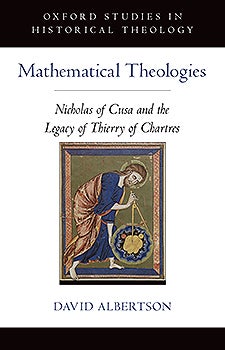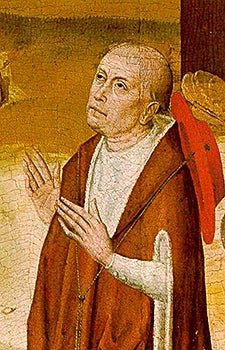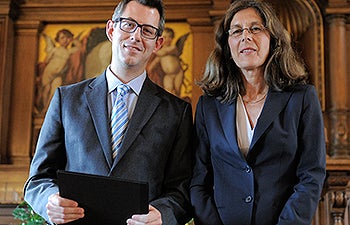Religion and Modern Science
David Albertson, assistant professor of religion at USC Dornsife, has been awarded a 2014 Manfred Lautenschlaeger Award for Theological Promise for his forthcoming monograph, Mathematical Theologies: Nicholas of Cusa and the Legacy of Thierry of Chartres (Oxford University Press, 2014).
In a ceremony on May 23, Albertson accepted his award from the chancellor of Heidelberg University in Heidelberg, Baden-Württemberg, Germany.
Founded by the John Templeton Foundation, the international book prize is administered by Heidelberg’s interdisciplinary research institute in Religion (Forschungszentrum Internationale und Interdisziplinäre Theologie). The $10,000 award is given annually to 10 junior scholars selected by an international committee from 19 countries for their first publication on the theme “God and Spirituality.” The Lautenschlaeger Foundation that currently funds the prize is one of the leading charities in Germany. Other winners came from Israel, Finland and England.
“I was particularly excited that this award came from Europe, and from a prominent and historic German university known for its leadership in religious studies, philosophy and sociology,” said Albertson, who is writing a new book on visual diagrams and geometry during the Renaissance and Reformation. “The award will help fund my travel needs for the book that I’m writing now — a sequel to the first.”

Published on June 17 by Oxford University Press, Albertson’s book focuses on numbers and arithmetic in European religious thought from antiquity through the Renaissance. Image courtesy of Oxford University Press.
Albertson began Mathematical Theologies in 2008 thanks to a Provost’s Advancing Scholarship in the Humanities and Social Sciences Grant, which enabled him to travel to Germany to study in the archives of Nicholas of Cusa’s 500-year old library.
His resulting award-winning monograph focuses on numbers and arithmetic in European religious thought from antiquity through the Renaissance.
“I also study contemporary philosophy and there is a lot of discussion about the essence of modernity in the 20th century, especially in the 1920’s and 30’s,” Albertson said. “Most of the definitions, whether you’re talking about politics or science, come back to the origins of the exact modern sciences. That basically means the application of mathematics to the sciences, or the so-called mathematization of nature in the 17th century.”
However, many of the sources Albertson discovered — by scholastic philosophers, mystical theologians and avant-garde Renaissance Platonists — were already using in-depth mathematical ideas in their religious writings.

Nicholas of Cusa by the Master of the Life of the Virgin, the pseudonym of a late Gothic German painter working in Cologne, Germany, who is sometimes identified as Johann van Duyren. Image courtesy of David Albertson.
“My question was: What does that mean if we see the same sort of mathematization of thought, but in a religious sphere, and well before the 17th century? Wouldn’t that have to challenge some of the categories that we still use to think about religion versus science, or medieval versus modern? It would overturn current thinking on the origins of modernity if we found very mathematized religious texts from, say, the 1100s.”
Albertson’s book also concentrates on the work of Thierry of Chartres.
Despite achieving fame during his lifetime, the ideas of the 12th-century French theologian Thierry of Chartres remained well outside the medieval mainstream. Three centuries later Nicholas of Cusa, a German canon lawyer, bishop, cardinal, theologian and philosopher, rediscovered anonymous fragments of Thierry and his medieval readers, and drew on them liberally in his early works.
“I wanted to examine the thinking of Thierry of Chartres and Nicholas of Cusa as two examples of mathematized Christian authors in the 12th and 15th centuries,” Albertson said. “I was curious to see how their ideas might answer some of the questions we’re still thinking about in the 21st century. What is the essence of modernity, why does religion have anything to do with it and why does religion keep hanging around if it was supposedly filtered out by the mathematical science of Galileo and Descartes?”

Albertson receives the award from Angela Kalous, chancellor of Heidelberg University, at a ceremony held in Germany on May 23. Image courtesy of FIIT/Heidelberg University.
In his book Albertson suggests that the writings of Thierry and Nicholas represent a lost history of encounters between Christianity and Pythagorean ideas before the Renaissance. Both authors used Greek number theory to reconceive fundamental Christian beliefs about the nature of the divine. Thierry proposed that the purest name for the Trinity was the equation 1 x 1 = 1. Nicholas took this a step further and explained that Jesus’s body was constructed from the mathematical building blocks of the cosmos. While historians are well aware of encounters between Christianity and other Greek philosophers, such as Plato, Aristotle, or the Stoics, no one had yet investigated the links between Christianity and Pythagoreanism, whose mathematical ideas were so important for the emergence of modern science.
“Past scholarship has tended to pigeonhole these authors into the wrong categories, which didn’t allow us to think of them in connection with contemporary questions about modernity,” he said. “If we reexamine them on their own terms, I think they represent an alternative possibility for a kind of modernity that makes room for a more amicable relationship between religion and science. Moving from medieval to modern doesn’t need to mean moving from a religious view of the cosmos to a scientific view of the cosmos, as if the two were opposed.”